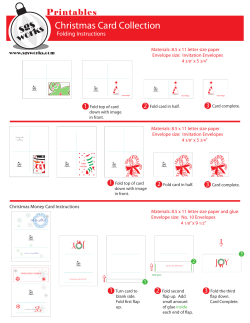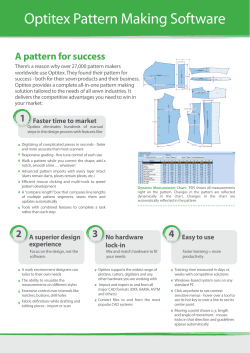
Tessellations CLOSING
CLOSING Thanks for reading this little booklet! I hope you enjoyed it. If you are interested in learning more about tessellations, I have a book coming out in the Fall of 2007 titled Origami Tessellations: Fantastic Paper Geometry from Lark Books, which features all of the above and much more. Tessellations a primer for OUSA 2007 Eric Gjerde Eric Gjerde ericgjerde@mac.com www.origamitessellations.com Aztec Twist, tessellated, backlit Deltoidal Trihexagonal Tiling + Stars, reverse, backlit Deltoidal Trihexagonal Tiling + Stars 2 | Tessellations: a Primer OUSA 2007 TESSELLATION BASICS This booklet is a brief introduction into origami tessellations, and a few of the basic techniques used to create complex designs out of simple repeating shapes. It is by no means complete, but hopefully will whet your appetite for trying out this interesting and unique style of folding. only one shape. These tessellations each consist of a single, repeating shape: equilateral triangles, squares, or hexagons. WHAT IS A TESSELLATION? One of the fundamental basics of origami tessellations is the concept of a pre-creased grid. Typically, this is used as a framework for the PRE-CREASING Have you ever looked at the patterns on a tile floor? The tiles you saw were most likely tessellations repeating patterns of specific shapes. In fact, the word “tessellation” comes from the Latin “tessella” meaning “small square” - which the Romans used for making mosaics and tile designs. ORIGAMI TESSELLATIONS Origami tessellations are geometric designs folded from a single sheet of paper, creating a complex repeating pattern of shapes from folded pleats and twists. They range from simple square tilings to extremely intricate pieces inspired by Islamic art, from twisted architectural flourishes to realistic faces formed from tessellated shapes. TILINGS There are three basic tessellation patterns, called “regular tessellations” which tile infinitely using placement and orientation of twists and pleats, which line up with the geometry of the grid itself. The two basic grid patterns that are used are squares NOTES 6 | Tessellations: a Primer OUSA 2007 5. The paper should collapse along the valley folds so the entire piece is folded in half. 6. Once the twist is folded in half, open the two halves of the ‘book’ while holding the base together. 7. The twist should open up and lie flat. Once the hex twist has been folded, it locks the paper into place, and it can be quite difficult to unfold. This makes it a very useful tool when folding complicated patterns, as it does a good job of holding complex folded designs together. Tessellations: a Primer OUSA 2007 | 3 and equilateral triangles, since all three regular tessellations (triangles, squares, and hexagons) can be created from these two grids. Accuracy is of critical importance when folding these patterns. Since you are creating the majority of the creases in your tessellation as part of the grid, it’s a necessity for your lines to match up with each other and for the pleats to be of equal width. If you find that you are off a bit at first, focus your efforts on making your first few folds as accurate as possible, as they are the cornerstone of the foundation in your pre-creased grid. PLEAT INTERSECTIONS Folding pleat intersections is one of the fundamental concepts in origami tessellations. These can take the form of twists, such as the triangle, square, or hexagon twist we will see later on, or they can be a simple arrangement laying on top of one another. Almost every tessellation is constructed from a combination of these two ideas. 120 DEGREE PLEAT INTERSECTION This is a very simple pleat intersection, using a triangular grid. 1. Identify the pleats that you wish to fold; pinch the paper together to form the actual pleat itself. 2. When all the pleats are pinched together, fold the pleats over in the direction you want them to lay. 3. The pleats should now be laying flat on the paper. 90 DEGREE PLEAT INTERSECTION 1. Using a square grid, fold a single pleat. 2. Unfold the first pleat, and fold a second pleat crossing over the first one. 3. Unfold this pleat as well, and then pinch the folds together along the diagonal creases shown. 4. Fold the lower flaps outwards, and fold the tip over on the diagonal lines. 5. It should lie flat on the paper when finished. 6. This pleat intersection can be changed in several different ways. Often the lower flaps are folded inwards, to make a flap that can be used for interesting purposes in tessellation designs. 7. To fold this, just change the orientation for the lower flaps so they fold inwards rather than from valley to mountain folds. 4 | Tessellations: a Primer OUSA 2007 8. The finished fold should lie flat on the paper, and should look a bit like a bird’s mouth. Tessellations: a Primer OUSA 2007 3. Hold down the three corners of the triangle and pull on them slightly. This will exert pressure on the center of the triangle, and make it start to spread out. Encourage this process along by pushing down on the center of the triangle. 4. Continue pushing the triangular section flat, going all the way out to the corners. Your triangle twist is complete! place- it’s much faster and quite satisfying to do, almost like popping bubble-wrap. 1. 2. 3. 6. 1. Start with a pre-creased grid of triangles (as shown in earlier basics segment). Locate your three pleats, and fold them along the mountain / valley folds indicated on the diagram. 2. The pleats will start to pull together - you’ll notice that paper builds up in the center. This extra paper is required for the paper to twist. Help this along by folding the pleats over in the same direction, rotating around the central meeting point of the pleats. The result will be a triangular peak at the center. SQUARE TWIST This twist can be made more quickly by simply squashing a 90 degree pleat intersection; this is an easier way to learn it, initially. Once you understand how the twist works, feel free to squash it into 5 HEX TWIST 4. 5. TRIANGLE TWIST | 1. To fold the twist, start with a triangular grid. This twist can also be made by squashing a sixpleat intersection, similar to the triangle and Identify your mountain and valley folds on your square twist. However it is a bit tricky to do this, square grid, and pre-crease the diagonal creases. so a learning method is illustrated here. Start folding the paper along these creases. 2. Identify the pleat lines to be used, and fold them Collapse the paper inwards, following the crease accordingly with mountain or valley folds as lines. indicated. While collapsing, fold the paper in half. 3. Collapse the paper inwards, along the crease Fold the paper along the remaining unfolded lines. valley folds. 4. Start to twist the paper slightly, while folding it Open the paper up so it lies flat. That’s all there half. is to it!
© Copyright 2025



















